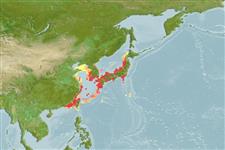Environment: milieu / climate zone / depth range / distribution range
Ökologie
seewasser demersal; standorttreu; tiefenbereich 0 - 30 m (Ref. 6205). Subtropical; 45°N - 21°N, 116°E - 149°E (Ref. 6205)
Northwest Pacific: Japan, Korea, China, and Taiwan. Possibly to the Philippines. Commonly misidentified as Sillago sihama.
Size / Gewicht / Alter
Maturity: Lm ? range ? - ? cm
Max length : 30.0 cm TL Männchen/unbestimmt; (Ref. ); common length : 22.0 cm SL Männchen/unbestimmt; (Ref. 6205)
Rückenflossenstacheln (insgesamt): 12; Rückenflossenweichstrahlen (insgesamt): 21-23; Afterflossenstacheln 2; Afterflossenweichstrahlen: 22 - 24; Wirbelzahl: 35. Swim bladder with anterior projecting extensions and a single posterior extension. Body is greenish gray above, the dorsal part of the head being the darker, and whitish below. The fins are mostly hyaline; the membrane between the first to the third dorsal fin spines with minute dark brown dots; the margins of the dorsal fin with a few dark brown spots. The caudal fin with dark margins.
Occur in bays on shallow sandy flats. Maximum size is over 30 cm (Mark Donachy, pers. comm., 2001). Oviparous (Ref. 205). Greatly esteemed for its delicate flavor (Ref. 6205).
Life cycle and mating behavior
Geschlechtsreife | Fortpflanzung | Ablaichen | Eier | Fecundity | Larven
McKay, R.J., 1992. FAO Species Catalogue. Vol. 14. Sillaginid fishes of the world (family Sillaginidae). An annotated and illustrated catalogue of the sillago, smelt or Indo-Pacific whiting species known to date. Rome: FAO. FAO Fish. Synop. 125(14):87p. (Ref. 6205)
IUCN Rote Liste Status (Ref. 130435)
Bedrohung für Menschen
Harmless
Nutzung durch Menschen
Fischereien: kommerziell; Aquakultur: zukünftige nutzung
Mehr Information
NamenSynonymeMetabolismusRäuberÖkotoxikologieFortpflanzungGeschlechtsreifeAblaichenSpawning aggregationFecundityEierEientwicklung
ReferenzenAquakulturAquakultur ProfilZuchtlinienGenetikElectrophoresesVererbbarkeitKrankheitenVerarbeitungNutrientsMass conversion
PartnerBilderStamps, Coins Misc.LauteCiguateraGeschwindigkeitSchwimmstilKiemenoberflächeOtolithsGehirngrößeSehfähigkeit
Tools
Zusatzinformationen
Download XML
Internet Quellen
Estimates based on models
Preferred temperature (Ref.
123201): 16.1 - 25.4, mean 21.3 °C (based on 238 cells).
Phylogenetic diversity index (Ref.
82804): PD
50 = 0.5000 [Uniqueness, from 0.5 = low to 2.0 = high].
Bayesian length-weight: a=0.00631 (0.00395 - 0.01009), b=3.05 (2.91 - 3.19), in cm total length, based on LWR estimates for this species & Genus-body shape (Ref.
93245).
Trophic level (Ref.
69278): 3.5 ±0.52 se; based on food items.
Widerstandsfähigkeit (Ref.
120179): hoch, Verdopplung der Population dauert weniger als 15 Monate. (Preliminary K or Fecundity.).
Fishing Vulnerability (Ref.
59153): Low vulnerability (20 of 100).
